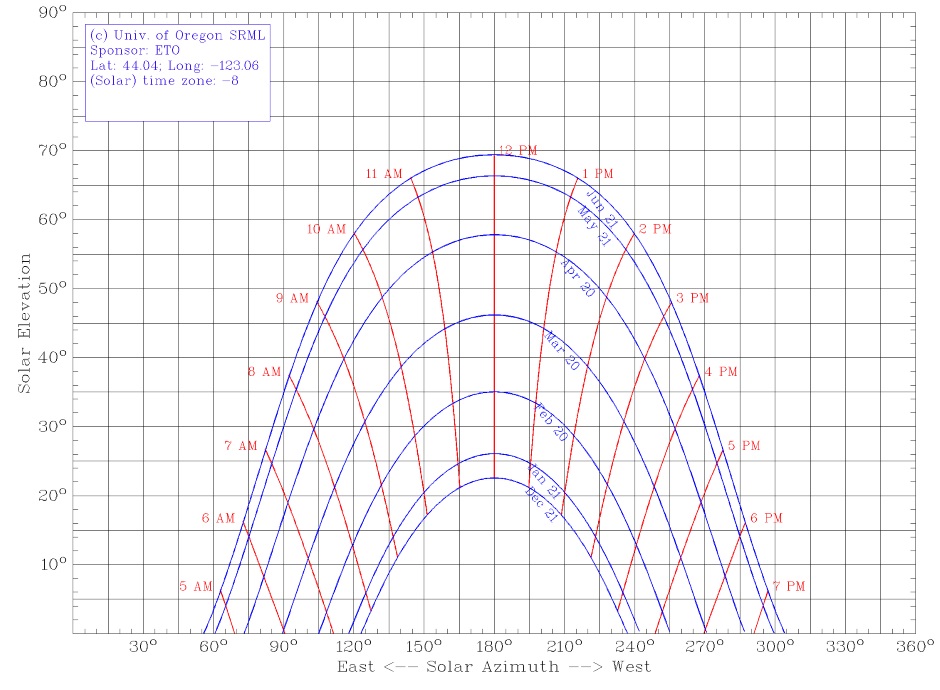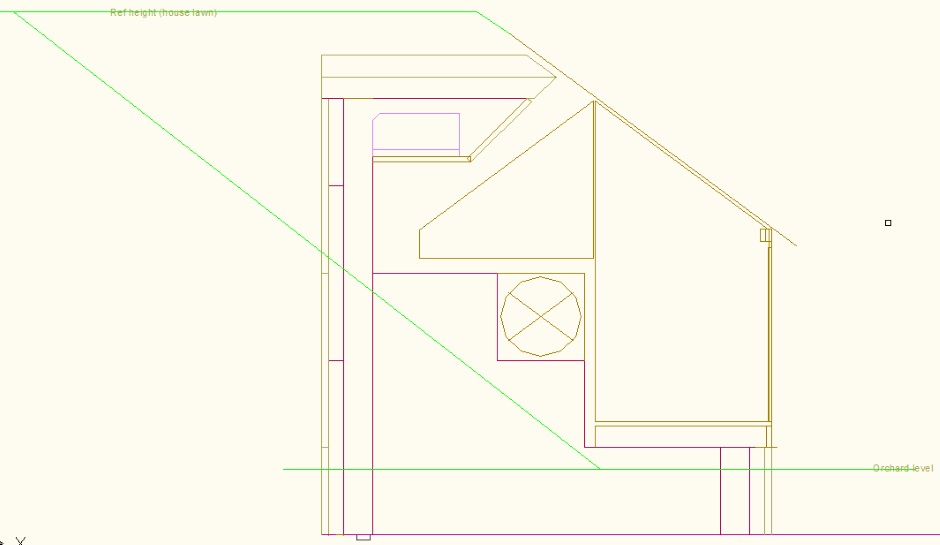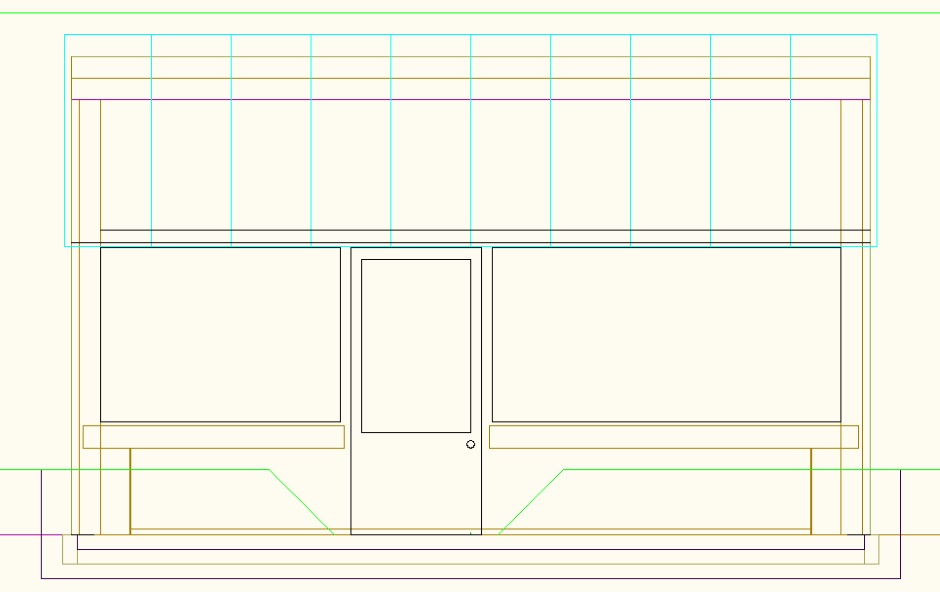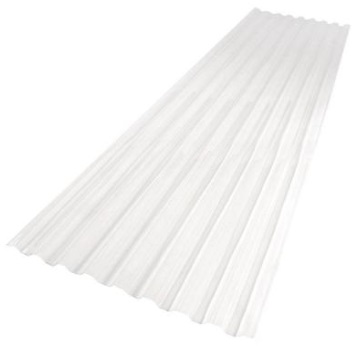Home Site Map - Techniques - Plot Infrastructure -
Greenhouses
![]() Make a nice environment for growing plants.
Make a nice environment for growing plants.
Two types of greenhouses are considered here. One design that has high thermal mass and one that is suitable for use on a raised platform. The raised platform type is useful in a forest as a way to get sunlight to the greenhouse. A high thermal mass greenhouse is best if you are in a relatively cold climate as it avoids frost.
General principles
You need the greenhouse to get lots of sunlight. That means that the south wall needs to be transparent and ideally the east and west walls too. There is no point in making the north wall transparent and making it transparent would be a negative because instead you want the north wall well insulated.
Sun orientation
A useful web site to find sun paths from your zip code is http://solardat.uoregon.edu/SunChartProgram.html . Here is the plot for my area...

Air tight
Loosing warm air is the biggest source of heat loss so a greenhouse needs to be air-tight with specific ventilation at just the required times. Ideally you would use an HRV (Heat Recovery Ventilator) but that is likely to be more money than you want to spend.
A large fan with a closable gasketed shutter over it is a low cost solution. Provide a permanent fine wire mesh over the fan to filter out insects. It is best to make the fan blow air into the greenhouse (rather than using an extractor fan) because plants like their leaves to be blown around a bit.
Roof
Particularly the south slope of the roof needs to be transparent. Glass is a poor choice because it does not support weight and can also be broken by hail stones. A better choice is corrugated clear Polycarbonate roofing sheets.
There is no particular need to look through the roof so you don't need 100% transparency. You do want it to let in at least 90% of the light.
SunTuf is the best panel available (most UV resistant), but there is also PalRuf
available at 2/3 of the price.
12' versions of SunTuf are
available for $32.43, but I just need the 8' version for $21.62 (26" x
96").
It is good to design for adding a second internal layer of transparent roofing. You could potentially use the cheaper PVC sheets in the inside rather than Polycarbonate sheets as the outer Polycarbonate sheets will have filtered out most of the harmful UV.
Another possibility for the roof if you want better insulation is to use SunLite which is double walled Polycarbonate. This is $35.63 for a 2'x8' sheet. However sealing between sheets is much harder than using corrugated panels.
Wall windows
Ideally the windows in the south wall should be angled backwards at an angle that is your latitude + 35 degrees. For where I live (Seattle area which is 44 degrees latitude) that gives an ideal angle of 79 degrees. In practice I use the windows exactly vertical, ie 90 degrees, as this is close enough and makes construction easier.
If you just want single pane windows then use 8'x4' clear acrylic sheets. If you want a double layer (to provide dead air insulation) then you may find that using 8'x5' argon filled tempered glass double glazing ($350) is not much more expensive than two sheets of acrylic (that are each only 8'x4') (2.25 x $100). You do have to also consider solar gain which needs to be as high as possible. Probably it is more economic to use a single sheet of acrylic and make insulated covers that can be fitted on the few very frosty nights.
Use a table saw to cut indents in 2x4s to accept the acrylic sheets.
Thermal Mass Greenhouse
Thermal mass is provided by the concrete of the north wall (and to a lesser extent other shorter walls) and by the concrete slab. The sun heats the thermal mass during the day and the heat is released at night to keep the frost away. It even works in the winter to extract heat from the sun's rays and keep the greenhouse warmer than it would otherwise be. A term often used is "Passive Solar". There's more info on the effect of thermal mass here . Concrete is not quite as good at providing thermal mass in a greenhouse compared with water (concrete and rocks is able to store 40% less heat than water), but it does have the additional use of providing structure for the building.
You need lots of windows facing the direction the sun is coming from and you need to insulate all the walls where the sun is not coming from.
You should make the northern-most third of the roof non-transparent and well insulated. In the summer is stops the high in the sky sun from overheating the greenhouse and in the winter provides very little screening of the sun because the sun is lower in the sky. My design uses a thin strip of Carnation Flooring. This concrete roofing has polystyrene sheets above it and is strong enough to support 1 foot of soil above that, thus extending the lawn area.
Sinking the greenhouse into the ground by 2 feet is a good way to avoid frost without making much difference to the amount of useful sun rays you capture.
You ideally want the north wall to be white to reflect light back onto the plants and you ideally want it to be black to absorb heat. Gray (the natural color of concrete) is a good compromise between the two conflicting requirements.


Implementation notes
10' 9-1/2" deep x 18' 5-1/2" wide 10.79 x 18.46 = 199.18 sqft
Excavated orchard level (the land on the south side) is 10'6" below ref grade.
Where there is a
slab then excavate down an additional 2'6".
This is 13'
below ref grade and 2'6" below orchard level.
Top
of slab is 1'6" below orchard level.
Slab is 4" of
concrete, on 4" of EPS, on 4" of crushed rock.
Two horizontal 8'x4' acrylic clear panels on south wall. One cut acrylic panel on east and west walls. Total $400.
The door is in the middle of the south wall. This allows the east and west concrete walls to resist toppling of the north retaining wall. The door needs to be mainly transparent so it needs to be an acrylic panel in a 2x4 rectangle. The door needs to fit into an opening with a 1.5" lip all the way round (including the bottom).
A 4' wide grass slope is between the greenhouses so you can walk down and drive the ride-on lawnmower. It is also the separator between the allowed 200sqft buildings.
The transparent roof slope length is one 8' roof panel. Need 10 across width of roof (gives up to 1' overhangs, but it is best to overlap the sheets more and make the overlap only 2 inches). SunTuf is the best corrugated panel available. Total $220.
Carnation concrete walling for 10' north wall and 2' high south, east, and west walls. Against retaining wall the east and west walls are 6' high.
Under the concrete slab there is polystyrene (4"). The EPS extends up 4" to constrain the poured slab concrete. The slab is a raft of 4" thick concrete. There is rebar in the slab (1' grid) and it extends up into the walls with 1 foot on center.
The north edge of the roof uses a 4' strip of Carnation Flooring. If does not matter which way the looring is placed because either way a concrete lip is needed as it joins with the transparent roofing. The lip actually is formed to extend up an extra 9" to constrain the soil.
Bench on south side is 4' wide. Concrete short walls (2' high) support benches at a height of 2'6". North side of walkway is for tall plants and trees.
Waterproofing is needed on the backfilled walls and is best done with a 6mil polyethylene sheet. Put a drain round the foundations, done with 4" perforated pipe in crushed rock. Good drainage is important because it reduces pressure on the back wall.
Raised Platform Greenhouse
The design for this is not yet done. It involves an elevated wooden platform up in the trees, supported tree-house style from the existing trees. The main objective is to get more sunlight without having to clear a big area of forest. Being up high you also potentially get a nice view.
Use Garnier limbs (or equivalent) to attach to tree stumps.
http://www.treehousesupplies.com/sell-garnier-limbs_a/265.htm
Best bet http://www.treehousesupplies.com/Treehouse_Bolts_s/41.htm
http://www.treehousesupplies.com/Treehouse_Brackets_s/28.htm
When more than one tree is being used you need to use floating attachments http://www.treehousesupplies.com/Treehouse_Brackets_s/28.htm
Use 1-1/4" lab bolts http://www.treehousesupplies.com/Lag_Bolt_1_25x12_p/lb1.25x12gal.htm




